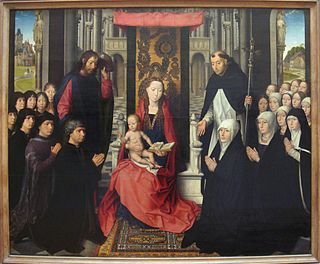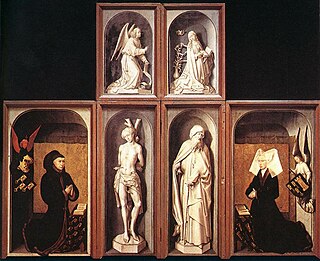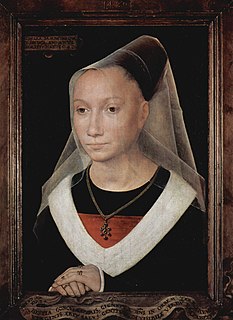
Hans Memling was a painter active in Flanders, who worked in the tradition of Early Netherlandish painting. He was born in the Middle Rhine region and probably spent his childhood in Mainz. He moved to the Netherlands and spent time in the Brussels workshop of Rogier van der Weyden. He was subsequently made a citizen of Bruges in 1465, where he became one of the leading artists, running a large workshop, which painted religious works that often incorporated donor portraits of his wealthy patrons. Memling's patrons included burghers, clergymen, and aristocrats.

Petrus Christus was an Early Netherlandish painter active in Bruges from 1444, where, along with Hans Memling, he became the leading painter after the death of Jan van Eyck. He was influenced by van Eyck and Rogier van der Weyden and is noted for his innovations with linear perspective and a meticulous technique which seems derived from miniatures and manuscript illumination. Today, some 30 works are confidently attributed to him. The best known include the Portrait of a Carthusian (1446) and Portrait of a Young Girl ; both are highly innovative in the presentation of the figure against detailed, rather than flat, backgrounds.

The Royal Museum of Fine Arts Antwerp is a museum in Antwerp, Belgium, founded in 1810, that houses a collection of paintings, sculptures and drawings from the fourteenth to the twentieth centuries. This collection is representative of the artistic production and the taste of art enthusiasts in Antwerp, Belgium and the Northern and Southern Netherlands since the 15th century.
The decade of the 1480s in art involved some significant events.
The decade of the 1470s in art involved some significant events.

The Beaune Altarpiece is a large polyptych c. 1445–1450 altarpiece by the Early Netherlandish artist Rogier van der Weyden, painted in oil on oak panels with parts later transferred to canvas. It consists of fifteen paintings on nine panels, of which six are painted on both sides. Unusually for the period, it retains some of its original frames.

Portrait of a Lady is a small oil-on-oak panel painting executed around 1460 by the Netherlandish painter Rogier van der Weyden. The composition is built from the geometric shapes that form the lines of the woman's veil, neckline, face, and arms, and by the fall of the light that illuminates her face and headdress. The vivid contrasts of darkness and light enhance the almost unnatural beauty and Gothic elegance of the model.

The Portrait of Folco Portinari is a painting by the German painter Hans Memling, dating to c. 1490. It is displayed in the Uffizi Gallery, in Florence.
Till-Holger Borchert is a German art historian and writer specialising in 14th and 15th-century art. He has been the chief curator of the Groeningemuseum and Arentshuis museums in Bruges, Belgium, between 2003 and 2014. In December 2014, he was appointed as director of the Municipal Museums in Bruges. In this role he initiated a radical reorganisation of the institution and laid the foundation for the renewal of infrastructure like the ticketing facility of the Gruuthusemuseum, a new storage and the exhibition park BRUSK designed by architect Paul Robbrecht. In November 2021 he was appointed as new director of the Suermondt Ludwig Museum in Aachen, a position he resumed in april 2022.

Sibylla Sambetha is a small oil on oak panel painting by Hans Memling, completed in 1480 and still in its original frame. It is now in the Hans Memling museum at the Old St. John's Hospital in Bruges and shows a young woman who is not pretty, but nonetheless elegant and well dressed. She is set against a black background and looks out of the picture as if she is at a window. Her hands are folded and rest on the lower border of the brown marbled frame, in an early and effective example of trompe-l'œil.

The Exposition des primitifs flamands à Bruges was an art exhibition of paintings by the so-called Flemish Primitives held in the Provinciaal Hof in Bruges between 15 June and 5 October 1902.

The St John Altarpiece is a large oil-on-oak hinged-triptych altarpiece completed around 1479 by the Early Netherlandish master painter Hans Memling. It was commissioned in the mid-1470s in Bruges for the Old St. John's Hospital (Sint-Janshospitaal) during the building of a new apse. It is signed and dated 1479 on the original frame – its date of installation – and is today still at the hospital in the Memling museum.

The Mystic Marriage of St. Catherine is a c. 1480 oil-on-oak painting by the Early Netherlandish painter Hans Memling, now in the Metropolitan Museum of Art, New York. The panel shows an enthroned Virgin holding the Child. St Catherine of Alexandria and St Barbara are seated alongside. Angels playing instruments flank the throne, while the male figure to left is presumably the person who commissioned it as a devotional donor portrait.

The Annunciation is an oil painting on oak panel attributed to Early Netherlandish painter Hans Memling. It depicts the Annunciation, the archangel Gabriel's announcement to the Virgin Mary that she would conceive and become the mother of Jesus, described in the Gospel of Luke. The painting was completed c. 1482 and was partially transferred to canvas in the 1920s; it is today held in the Robert Lehman collection of the Metropolitan Museum of Art in New York.

The Saint Columba Altarpiece is a large c. 1455 oil-on-oak wood panel altarpiece by Early Netherlandish painter Rogier van der Weyden, now in the Alte Pinakothek, Munich.

Portrait of Maria Portinari is a small c. 1470–72 painting by Hans Memling in tempera and oil on oak panel. It portrays Maria Maddalena Baroncelli, about whom very little is known. She is about 14 years old, and depicted shortly before her wedding to the Italian banker, Tommaso Portinari. Maria is dressed in the height of late fifteenth-century fashion, with a long black hennin with a transparent veil and an elaborate jewel-studded necklace. Her headdress is similar and a necklace identical to those in her depiction in Hugo van der Goes's later Portinari Altarpiece, a painting that may have been partly based on Memling's portrait.

Bathsheba are names given to a c 1480 oil on wood panel painting by the Early Netherlandish artist Hans Memling, now in the Staatsgalerie, Stuttgart. Its unusually close framing and the fact that many of the details are cut off suggests that it is a fragment of a larger, probably religious, panel or triptych that was broken up. The painting is noted for being a rare 15th century depiction of a nude person in Northern Renaissance art; such figures typically only appeared in representations of the Last Judgement, and were hardly as deliberately erotic. Memling is attributed one other secular nude portrait, in the center panel of his c. 1485 Vanitas allegory Triptych of Earthly Vanity and Divine Salvation, at the Musée des Beaux-Arts, Strasbourg. As opposed to Bathsheba, that nude is fully exposed, with visible genitalia.

The Diptych of an elderly couple is a pair of bust-length wedding portraits by Hans Memling, which were formerly attached with pegs and were split some time before they were sold separately in 1894. One is in the collection of the Gemäldegalerie and the other is in the collection of the Louvre. When viewed side by side the landscape background joins up to form a whole.

Portrait of a Man is a circa 1470 oil on panel painting by Hans Memling. It is now in the Frick Collection in New York, which it entered in 1968 via the Duveen art dealership.

The Pagagnotti Triptych is an oil-on-wood triptych by Hans Memling produced circa 1480. The original was disassembled and separated, with the center panel held at the Uffizi gallery in Florence and the two wing panels at the National Gallery in London.


















